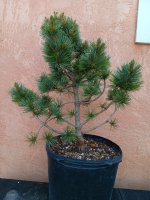NMbonsai
Yamadori
Last fall, I purchased a Southwestern white pine (Pinus strobiformus 'Loma Linda') in a three gallon nursery pot from an out of state nursery. The tree arrived in great condition and was covered in buds. I uppotted it into a five gallon pot with minimal disturbance to the root ball; just raking out and trimming some circling roots and raking out the sides to somewhat open up the outside of the root ball. The tree was originally grown in a rich organic soil containing a large quantity of wood chips and a fair amount of micorrhizae. A note that came with the tree recommended that it be planted in a mix with a large proportion of wood chips, which I did. It didn't say why, but I assume it was to encourage the growth of the micorrhizae. I put the tree in a larger pot to hopefully increase the trunk diameter and to help it adjust to the change of climate from it's original location. I plan on leaving it to grow out for a while before starting to develop it as a bonsai. As seen in the pictures, the tree has responded well to the uppotting and the application of time release granular fertilizer (17-6-12) in spring of this year. The apex is covered with new growth and tiny developing cones.
My questions are: 1) Although this apical growth is necessary for the desired trunk thickening, won't it also contribute to an energy imbalance that could lead to the loss of the lower branches needed for the later development as a bonsai?
2) Should I thin out the large quantity of branches at the apex and remove the cones that serve no useful purpose and are depleting some of the tree's vigor?
3) Should I do some needle plucking as well, which I understand (from a Bonsai Mirai podcast) can be done anytime during the growing season to balance growth and energy?
I respectfully wecome all comments and advice on this topic, especially from those members who have been successfully growing pines for years, which is much longer than I have.
My questions are: 1) Although this apical growth is necessary for the desired trunk thickening, won't it also contribute to an energy imbalance that could lead to the loss of the lower branches needed for the later development as a bonsai?
2) Should I thin out the large quantity of branches at the apex and remove the cones that serve no useful purpose and are depleting some of the tree's vigor?
3) Should I do some needle plucking as well, which I understand (from a Bonsai Mirai podcast) can be done anytime during the growing season to balance growth and energy?
I respectfully wecome all comments and advice on this topic, especially from those members who have been successfully growing pines for years, which is much longer than I have.





